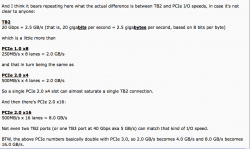Can you taste the potatoes?
Well said. PCIe support for the cMP was never great and will only deteriorate over time. In my experience it was never a "just works" experience and was always filled with compromises. As you say, a cMP with recent PCIe cards is arguably less effective and just as much work as building and maintaining a hackintosh.
There's not a lot of threads on this forum related to the nMP anymore, and while cMP advocates will say it's because there's nothing to upgrade, nMP owners know it's because we're spending more time getting **** done and less time posting inquiries on how to make our computer work properly.
This reminded me of a story about my old roommate. He swore that the pricey Vodka made in East Europe was vastly superior to the US made stuff. Once while he was gone for a few months I drank his bottle of Extra Special Vodka, couldn't tell the difference.
He came back a week early, along with a couple friends. I knew they would be heading for the liquor cabinet, so I quickly poured the $6.99 CVS rotgut special vodka into the pricey bottle. He and his friends savored every sip, completely unaware that they were drinking vodka made from corn husks and sawdust. The crowning moment was when one of them held the glass up and declared that he could "taste the potatoes".
Hearing these gleeful declarations of the death of PCIE cards reminds me of that. Do you guys know what TB is and how it actually works? Do you know how to write a driver for TB? Basically, you take a PCIE driver, and have to add little notes that tell it that it can tunnel through the bridges. And you should also include some instructions about what to do for pauses and interrupts.
One of the biggest problems is that TB introduces some serious latency issues that need to be addressed. So, as I have pointed out before, this wonderful new age of TB expandability is going to be just as bug prone as before. TB uses PCIE. PCIE hasn't gone anywhere, you just have it metered out to you now in small parcels.
Why is that? Because all that has happened is that you are going to need the same exact sort of drivers, but now with more little fixes added so they can be hot-plugged, etc.
So, same bus as PCIE, more complicated drivers, more latency issues. Oh, I forgot to mention that there is less than 1/4 of the bandwidth on a TB2 port then what is available in either of the bottom 2 slots in a 2009 cMP .
And less than 1/8 of the bandwidth the 6,1 Mac Pro would have had in a 16 lane slot of PCIE 3.0 had the Prototypes made it into production.
This to run peripherals using the same drivers, with more complications.
So, TB and nMP are not some big new break from the PCIE past. They are a limited and constrained version with much less capability. On the other hand, to have that connection at less than 1/4 of the bandwidth there is another change. It will now cost you $200-1000 to plug that greatly constrained PCIE device in, since it needs to be in a housing.
So I just don't get the glee over PCIE dying out. It's like you are celebrating having fewer choices but completely unaware that you are behaving like this is some "new thing" when it is in fact the same thing you had before, in a shiny package.
TB is great for laptops, not so great for something that never needed to be smaller in the first place.
So, TB is PCIE, just less of it for a whole lot more money.
Yay.
(BTW, not making this up, I have a dozen TB enclosures here, working on drivers for GPUs. I have also plugged PCIE SSDs in with these, they lose the expected speed due to TB inefficiencies)


